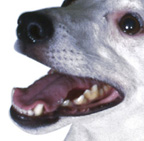Periodontal Disease in Pets
Flossing and mouth washes aren't required
- yet - but a brush and
clean are in order for your cats and dogs
MetPet.com Staff Writer
Periodontal diseases and disorders are problems with the teeth and gums. As food
and drink is chewed and ingested, a thin film of food and bacteria, known as
plaque, develops on the surface of teeth and around the gum line. If
left to harden, plaque becomes calculus which can be seen as yellowish
deposits around teeth particularly where they meet the gums.
 Although gum and tooth disease can appear minor, these
conditions can lead to much more serious consequences. Through the
mouth, bacteria can enter the bloodstream If left unattended, periodontal
disease can develop into a variety of unpleasant or life-threatening
disorders and diseases: Although gum and tooth disease can appear minor, these
conditions can lead to much more serious consequences. Through the
mouth, bacteria can enter the bloodstream If left unattended, periodontal
disease can develop into a variety of unpleasant or life-threatening
disorders and diseases:
- bad breath
- swollen, receding, bleeding gums
- tooth loss
- abcesses
- tonsillitis
- sinus infections
- bacterial infection of the bloodstream reaching the heart or kidneys and
resulting in heart or kidney failure in the most serious cases
Early symptoms of periodontal disease can include bad
breath, obvious signs of discomfort around the mouth, loss of appetite,
bleeding and loose teeth. Pets can begin forming plaque at a few years
of age so it's important to begin the dental hygiene routine as early as
possible.
Daily or frequent brushing
Foods and treats that are designed to keep teeth clean generally use some
type of physical cleaning effect. They tend to be harder to chew
causing individual teeth to sink into them thus creating a "brushing"
effect. Although there is evidence that these foods and treats do help
reduce plaque buildup, the most effective preventative is still the regular
brushing of the teeth and gums with a pet toothpaste and brush.
Pet toothpaste is meant to be ingested and is flavored to be palatable
(for example, liver or malt flavored). Human toothpaste is not meant
to be ingested in large quantities and can lead to gastrointestinal upset.
You can start off the kitten or the puppy with a piece of gauze wrapped
around your index finger and gently swabbed around his mouth. You can
then add some pet-friendly flavored toothpaste and then graduate to
fingertip brush. If you prefer using human brushes, look for soft
bristles with compact heads for maximum reach. Some larger dogs
actually enjoy having their teeth brushed with an electric toothbrush but
they are definitely in the minority.
As with human teeth cleaning, it's important to do this daily whenever
possible and for a minute or more whenever possible.
Veterinary Teeth Cleaning
Depending on the pet, teeth cleaning, involving the
scaling and polishing of teeth with special instruments under general
anesthesia or sedation by a veterinarian, can be required from time to time.
There is a wide range of individual susceptibility to plaque buildup and
periodontal disease, in addition, the use of general anesthesia, especially
in older or sickly individuals, can be both expensive and is not without
some health risks.
The older the pet, the riskier and generally more expensive the procedure
due to the additional tests and monitoring recommended to minimize the risks
of general anesthesia. If you are planning on having your pet's teeth
cleaned, consider other procedures that could be done to take advantage of
the sedation. This will help keep costs down as well as reduce the
risk to your pet.
Some veterinarians suggest a once or twice a year cleaning
schedule for pets with a high susceptibility to periodontal disease and
plaque buildup. Other pets can have a cleaning every five years while other
pets never have their teeth cleaned.
Related information:
What
To Do About Doggy Breath
|
